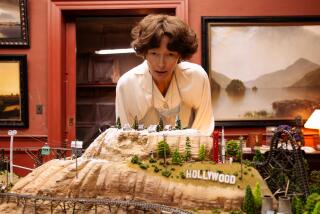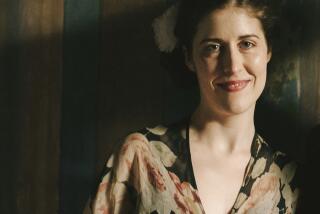Book Review : A Coarsened Caricature of ‘Literature’
First Light by Peter Ackroyd (Grove. $19.95. 336 pages.)
The effect of Peter Ackroyd’s “First Light” is the effect of draping quotation marks around some markedly signifying word or phrase.
In other words, “First Light” is not haunting, evocative and ironic. It is “haunting, evocative and ironic.” It is not, to get down to the tachycardic heart of the matter, strongly suggestive of the works of Iris Murdoch. It is “strongly suggestive of the works of Iris Murdoch.”
It is all self-consciousness and self-reference. Instead of a refined variation on Murdoch’s world of sophisticated intellectuals moving to primeval rhythms, it is a coarsening, a caricature; though lacking in the caricature’s virtue of letting air out of literary tires. Ackroyd pumps more air in.
Murdoch is not caricature-proof, but at her best she performs a striking union of civilization and myth. In her intelligent Oxford smiles there is the wink of a feral eyetooth. In Ackroyd’s novel about the spells released when a group of scientists excavate a Neolithic tumulus in the West of England, it is all dripping eyeteeth, and Day-glo brocade. In quotes.
A Fractious Group
Mark Clare is the leader of the fractious party that sets to work on the great grave, whose shape is accidentally revealed when a fire burns the brush that had concealed it. He is earnest, soulful and hard-working, but his progress is continually interrupted by the detonations of those around him. Shovels disappear, strange figures are seen flitting here and there, one of the party is shoved into a trench and breaks her arm, and the excavators’ field-office is vandalized. The barrow is set at some major cosmic intersection; the story is a continuous ectoplasmic traffic jam.
A sky-map, thousands of years old and inscribed on a tomb entrance, shows the same pattern of stars that the excavators are working under now. This feeds the growing madness of Damien, a local astronomer--he has long been depressed by the seeming lack of coherence in modern astrophysics--who now becomes convinced that the Big Bang has been reversed and that all matter is rushing back towards him personally.
Mark’s wife Kathleen is crippled and neurasthenic. She is perpetually convinced that he is about to be killed, and when he would come home of an evening, Ackroyd writes, “Her thin, pale face was suffused with light.” Eventually she is drawn to an ancient woodland tower and jumps off it, fatally.
Modern Links
A laconic farmer and his son--Farmer Mint and Boy Mint--sneak around, utter gnomic phrases and are clearly linked to the odd goings-on. Ackroyd intends them as modern-day survivors of the old Neolithic rite that shaped the tomb.
Joey, a retired music-hall performer and his wife, Floey, wander through in search of a particular cottage that he, an orphan, has dreamed of as his birthplace. He is all quips and turns; she is a steady fount of malapropisms. “It’s a mute point,” she will say, and refers to their quest “as a wild duck chase.” Before the end, they will be embraced by the Mints as their cousins, and Joey will be initiated into legend under a crown of antlers.
Evangeline, described as a high official from the Department of the Environment, is a constant chivying and exclamatory presence. She is flamboyantly lesbian and feels estranged from her father. Ackroyd makes her not simply odd, but so improbably odd that at each of her frequent appearances, anything else that may be going on is eclipsed by our feeling that something has gone wrong. Not with the cosmos, as the author perhaps intends, but with his book.
‘Something Old’
“Something very ancient has entered me,” she announces at her first visit to the tumulus. “Something old and precious is inside me now.” What are the “large, squelchy things?” she asks, coming to a pigsty. “Aren’t you gorgeous?” she exclaims when she meets Boy Mint. Spying Farmer Mint’s livestock, she burbles: “And cows too. Do you get many of them in the country?”
Alongside all this, the excavation itself is rather prosaic. Eventually, after a number of wrong guesses, Mark comes upon the main burial chamber. The single coffin is inscribed “Old Barren One”: It is the original Mint, the one his descendants have been protecting. To prevent its desecration, Joey, in post-antlered solemnity, steals and burns it.
“And suddenly Evangeline knew that her father was standing beside her; smiling she turned to him,” Ackroyd writes. “She talked to him but he made no sound. Mark was with Kathleen again as he knew he always would be. Joey put his arms around his parents who had returned to him at last.”
As for the Mints, they “did not need to turn around to know that there were others with them, too, a whole concourse of people who stood and watched silently. But they felt no fear. It was as they had always been told. No one is ever dead, and at this moment of communion a deep sigh arose from the earth and traveled upward to the stars.”
After so many arbitrary and dandyish shifts of tone, of character, of plot, this climax is not moving; it is “moving.” Ackroyd’s book rings deliberately untrue; he has written not a novel but a “novel.” He makes me feel like a “reader.” This, however, is not a “criticism”; it is a criticism.
More to Read
Sign up for our Book Club newsletter
Get the latest news, events and more from the Los Angeles Times Book Club, and help us get L.A. reading and talking.
You may occasionally receive promotional content from the Los Angeles Times.






